Compression Loading Behaviour of Anonna squamosa Seeds for Sustainable Biodiesel Synthesis
Abstract
1. Introduction
2. Materials and Methods
2.1. Collection and Preparation of A. squamosa Seeds
2.2. Determination of Initial Moisture Content of A. squamosa Seeds
2.3. Conditioning of A. squamosa Seed Moisture Content
2.4. Determination of Mechanical Properties of A. squamosa Seeds
2.5. Determination of the Hardness A. squamosa Seed
2.6. Data Analysis
3. Results and Discussions
3.1. Moisture Content of A. squamosa Seed
3.2. Effect of Loading Speeds on Mechanical Properties of A. squamosa Seed Under Compression Loading Behavior
3.2.1. Effect of Loading Speeds on Rupture Force and Energy
3.2.2. Effect of Loading Speeds on Bioyield Force and Energy
3.2.3. Effect of Loading Speed on Deformation at Rupture Point
3.2.4. Effect of Loading Speed on Hardness of A. squamosa Seed
3.3. Effect of Moisture Contents on Mechanical Properties of A. squamosa Seed Under Compression Loading
3.3.1. Effect of Moisture Content on the Seed’s Rupture Force and Energy
3.3.2. Effect of Moisture Content on Bioyield Force and Energy of A. squamosa Seed
3.3.3. Effect of Moisture Content on Deformation at Rupture Point
3.3.4. Effect of Moisture Content on A. squamosa Seed Hardness
4. Application of the Obtained Data to Biodiesel Feedstock Processing
5. Conclusions
- The effect of loading speeds and moisture contents on the rupture force, rupture energy, bioyield force, bioyield energy, deformation at rupture point and hardness was significant at level of ANOVA for the horizontal and vertical orientations.
- The differences between the mean data of rupture force and energy, bioyield force, and energy, deformation at rupture point and hardness of the seed at all experimental loading speeds and moisture contents for the two loading orientations were found to be statistically significant (, except between 22.6 and 32.5% (horizontal), and 15.4 and 32.5% (vertical) moisture levels.
- The correlations between loading speeds, moisture contents and the parameters under compressive loading behavior of A. squamosa seeds were mostly linear except for deformation (horizontal and vertical), and hardness (vertical), which were polynomial with moisture contents only.
- The coefficient of correlation () for the developed regression models, was high for the loading speed and moisture contents of the seed.
Author Contributions
Funding
Data Availability Statement
Acknowledgments
Conflicts of Interest
Abbreviations
| DB | Dry basis |
| MC | Moisture content |
| ASABE | American Society of Agricultural and Biological Engineers |
| ANOVA | Analysis of Variance |
| SPSS | Statistical Package for the Social Sciences |
| DMRT | Duncan’s multiple range test |
References
- Oladipo, B.; Betiku, E. Optimization and kinetic studies on conversion of rubber seed (Hevea brasiliensis) oil to methyl esters over a green biowaste catalyst. J. Environ. Manag. 2020, 268, 110705. [Google Scholar] [CrossRef]
- Oloyede, C.T.; Jekayinfa, S.O.; Alade, A.O.; Ogunkunle, O.; Otung, N.-A.U.; Laseinde, O.T. Exploration of agricultural residue ash as a solid green heterogeneous base catalyst for biodiesel production. Eng. Rep. 2022, 5, e12585. [Google Scholar] [CrossRef]
- Betiku, E.; Okeleye, A.A.; Ishola, N.B.; Osunleke, A.S.; Ojumu, T.V. Development of a Novel Mesoporous Biocatalyst Derived from Kola Nut Pod Husk for Conversion of Kariya Seed Oil to Methyl Esters: A Case of Synthesis, Modeling and Optimization Studies. Catal. Lett. 2019, 149, 1772–1787. [Google Scholar] [CrossRef]
- Safira, A.; Widayani, P.; An-Najaaty, D.; Rani, C.A.M.; Septiani, M.; Putra, Y.A.S.; Solikhah, T.I.; Khairullah, A.R.; Raharjo, H.M. A Review of an Important Plants: Annona squamosa Leaf. Pharmacogn. J. 2022, 14, 456–463. [Google Scholar] [CrossRef]
- Eshra, D.H.; Shehata, A.R.; Ahmed, A.A.; Saber, J.I. Physicochemical Properties of the Seed Kernels and the Oil of Custard Apple (Annona squamosa L.). Int. J. Food Sci. Biotechnol. 2019, 4, 87–93. [Google Scholar] [CrossRef]
- Oloyede, C.T.; Adebayo, J.M.; Jekayinfa, S.O.; Uduaghan, A.A. Moisture-modulated thermo-physical analysis of sweetsop seed (Annona squamosa L.): A potential biofuel feedstock plant. Food Process Eng. 2024, 47, e14684. [Google Scholar] [CrossRef]
- Hotti, S.R.; Hebbal, O.D. Biodiesel production process optimization from Sugar Apple Seed Oil (Annona squamosa) and Its Characterization. J. Renew. Energy 2015, 2015, 148587. [Google Scholar] [CrossRef]
- Chandio, F.A.; Li, Y.; Ma, Z.; Ahmad, F.; Syed, T.N.; Shaikh, S.A.; Tunio, M.H. Influences of moisture content and compressive loading speed on the mechanical properties of maize grain orientations. Int. J. Agric. Biol. Eng. 2021, 14, 41–49. [Google Scholar] [CrossRef]
- Onwe, D.N.; Umani, C.K.; Olosunde, W.A.; Ossom, I.S. Comparative analysis of moisture-dependent physical and mechanical properties of two varieties of African star apple (Chrysophyllum albidum) seeds relevant in engineering design. Sci. Afr. 2020, 8, e00303. [Google Scholar] [CrossRef]
- Oniya, O.O.; Oloyede, C.T.; Akande, F.B.; Adebayo, A.O.; Onifade, T.B. Some Mechanical Properties of Soursop Seeds and Kernels at Different Moisture Contents under Compressive Loading. Res. J. Appl. Sci. Eng. Technol. 2016, 12, 312–319. [Google Scholar] [CrossRef]
- Li, Y.; Chandio, F.A.; Ma, Z.; Lakhiar, I.A.; Sahito, A.R.; Ahmad, F.; Mari, I.A.; Farooq, U.; Suleman, M. Mechanical strength of wheat grain varieties influenced by moisture content and loading rate. Int. J. Agric. Biol. Eng. 2018, 11, 52–57. [Google Scholar] [CrossRef]
- Kabutey, A.; Herak, D.; Choteborsky, R.; Sigalingging, R.; Mizera, C. ScienceDirect Effect of compression speed on energy requirement and oil yield of Jatropha curcas L. bulk seeds under linear compression. Biosyst. Eng. 2015, 6, 8–13. [Google Scholar] [CrossRef]
- Mirzable, A.H.; Hajiahmad, A.; Asadollahzadeh, H.A. Moisture-dependent engineering properties of arugula seed relevant in mechanical processing and bulk handling. Food Process Eng. 2021, 44, e13704. [Google Scholar] [CrossRef]
- Olayanju, T.M.A.; Osueke, C.; Dahunsi, S.O.; Okonkwo, C.E.; Adekunle, N.O.; Olarenwaju, O.O.; Oludare, A. Mechanical behaviour of Moringa oleifera seeds under compression loading. Int. J. Mech. Eng. Technol. 2018, 9, 848–859. [Google Scholar]
- Li, Y.; Ali, F.; Ma, Z.; Zaman, M.; Li, B. Post harvesting technology: Effects of moisture content and loading speed on shearing failure of paddy grains. Int. Agric. Eng. J. 2018, 27, 342–349. [Google Scholar]
- Sudhir, S.; Akshay, P.; Rama, S.; Pradhan, C.; Mishra, S. Effect of Moisture and Axes Orientation on the Mechanical Properties of the Myrobalan Fruits and its Seed Under Compressive Loading. J. Inst. Eng. Ser. A 2020, 101, 679–688. [Google Scholar] [CrossRef]
- Aaqib, M.; Singh, C.; Kumar, H. Computation of design-related engineering properties and fracture resistance of plum (Prunus domestica) kernels to compressive loading. J. Agric. Food Res. 2021, 3, 100101. [Google Scholar] [CrossRef]
- Etim, P.J.; Alonge, A.F.; Akpan, G.E. Effect of moisture content on some mechanical and frictional properties of mucuna bean (Mucuna crens) relevant to its cracking. Agric. Eng. Int. CIGR J. 2021, 23, 265–273. [Google Scholar]
- Adeyanju, J.A.; Abioye, A.O.; Adekunle, A.A.; Olokoshe, A.A.; Ibrahim, T.H.; Faboade, A.L. Investigation on the effect of moisture content on physical and thermal properties of ofada rice (Oryza sativa L.) relevant to post-harvest handling. LAUTECH J. Eng. Technol. 2021, 15, 108–116. [Google Scholar]
- Mousaviraad, M.; Tekeste, M.Z. ScienceDirect Effect of grain moisture content on physical, mechanical, and bulk dynamic behaviour of maize. Biosyst. Eng. 2020, 195, 186–197. [Google Scholar] [CrossRef]
- Hashemifesharaki, R. Moisture-Dependent Engineering Characterization of Psyllium Seeds: Physical, Frictional, Aerodynamic, Mechanical, and Thermal Properties. Biosyst. Eng. 2021, 45, 374–384. [Google Scholar]
- Jan, K.N.; Panesar, P.S.; Singh, S. Effect of moisture content on the physical and mechanical properties of quinoa seeds. Int. Agrophys. 2019, 33, 41–48. [Google Scholar] [CrossRef]
- Simbeye, D.S. Computerized Measurement and Control System of the Universal Testing Machine Based on Virtual Instruments. J. Inf. Sci. Comput. Technol. 2016, 5, 456–465. Available online: www.scitecresearch.com/journals (accessed on 12 July 2024).
- Oloyede, C.T.; Akande, F.B.; Oniya, O.O. Moisture dependent physical properties of sour-sop (Annona muricata L.) seeds. Agric. Eng. Int. CIGR J. 2015, 17, 185–190. [Google Scholar]
- Jaiyeoba, K.; Idowu, D.; Oloyede, C.; Akande, F.; Oniya, O.; Popoola, A.; Jekaayinfa, S. Exploring soursop kernel as a sustainable biofuel: Analyzing physical and solid flow properties for feasibility assessment. LAUTECH J. Eng. Technol. 2022, 16, 190–199. [Google Scholar]
- Zareiforoush, H.; Komarizadeh, M.H.; Alizadeh, M.R.; Tavakoli, H.; Masoumi, M.; Komarizadeh, M.H.; Alizadeh, M.R.; Tavakoli, H. Effects of Moisture Content, Loading Rate, and Grain Orientation on Fracture Resistance of Paddy (Oryza sativa L.). Int. J. Food Prop. 2012, 15, 89–98. [Google Scholar] [CrossRef]
- Hasseldine, B.P.J.; Gao, C.; Joseph, M.; Jung, H.; Jang, T.; Song, J. Mechanical Response of Common Millet (Panicum miliaceum) Seeds under Quasi-static Compression: Experiments and Modeling. J. Mech. Behav. Biomed. Mater. 2017, 73, 102–113. [Google Scholar] [CrossRef]
- Mishra, C.S.R.C.P.S. Influence of Moisture Content and Compression Axis on Physico-mechanical Properties of Shorea robusta Seeds. J. Inst. Eng. Ser. A 2018, 99, 279–286. [Google Scholar] [CrossRef]
- Fadeyibi, A.; Osunde, Z.D. Mechanical Behaviour of Rubber Seed under Compressive Loading. Curr. Trends Technol. Sci. 2012, 1, 2279–2535. [Google Scholar]
- Vasilachi, C.; Biris, S.S.; Gheorghe, G. Study of the compression behaviour of grape seeds using the Finite Element Method. E3S Web Conf. 2020, 180, 128–136. [Google Scholar] [CrossRef]
- Nyorere, O.; Uguru, H. Full-text Available Online at Effect of Loading Rate and Moisture Content on the Fracture Resistance of Beechwood (Gmelina arborea) Seed. J. Appl. Sci. Environ. Manag. 2018, 22, 1609–1613. [Google Scholar] [CrossRef]
- Jadhav, M.L.; Maharani, D.; Nandede, B.; Kumar, M. Engineering Properties of Paddy and Wheat Seeds in Context to Design of Pneumatic Metering Devices. J. Inst. Eng. Ser. A 2020, 101, 281–292. [Google Scholar] [CrossRef]
- Soyoye, B.O.; Ademosun, O.C.; Agbetoye, L.A.S. Determination of some physical and mechanical properties of soybean and maize in relation to planter design. Agric. Eng. Int. CIGR J. 2018, 20, 81–89. [Google Scholar]
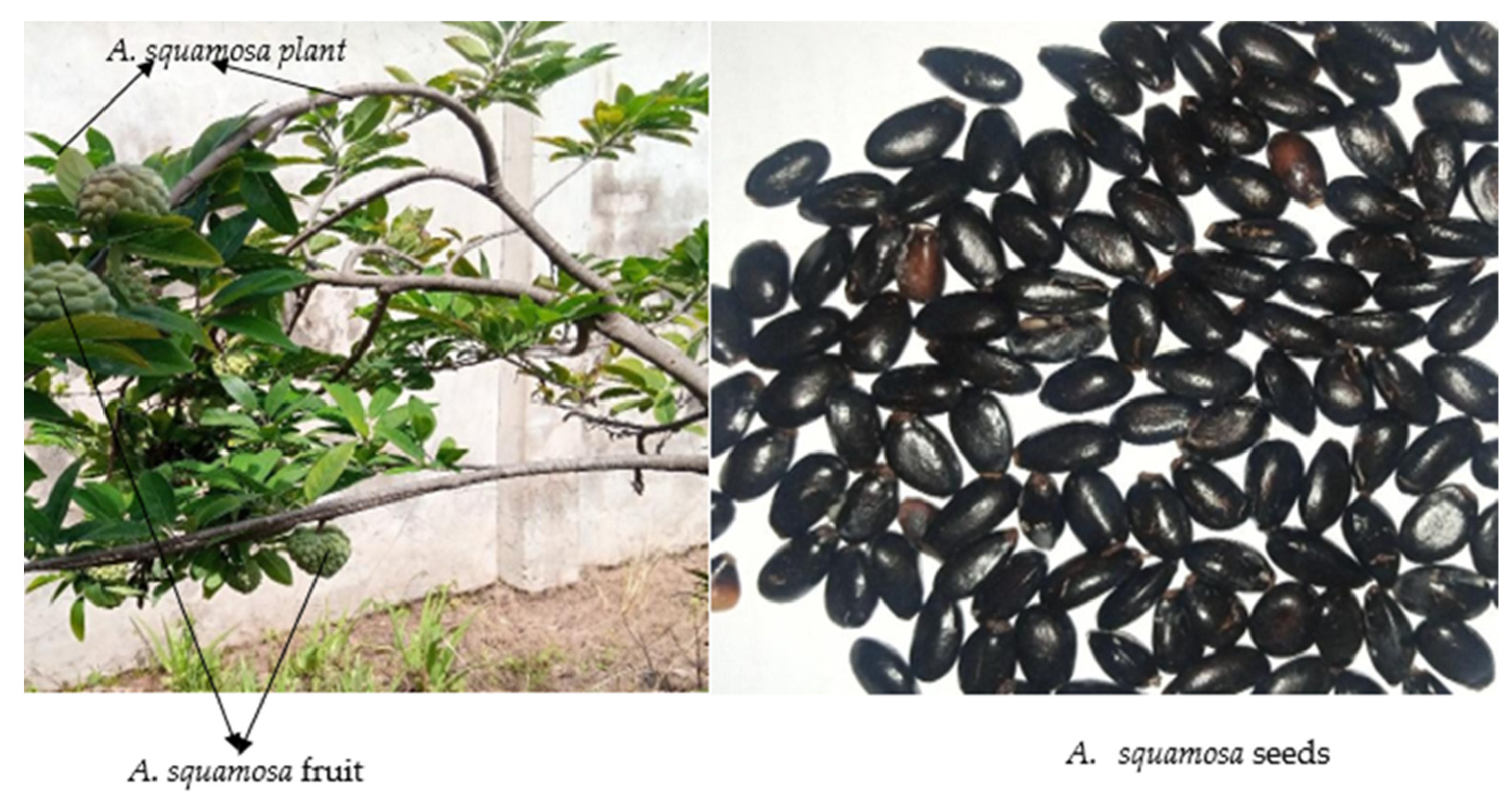
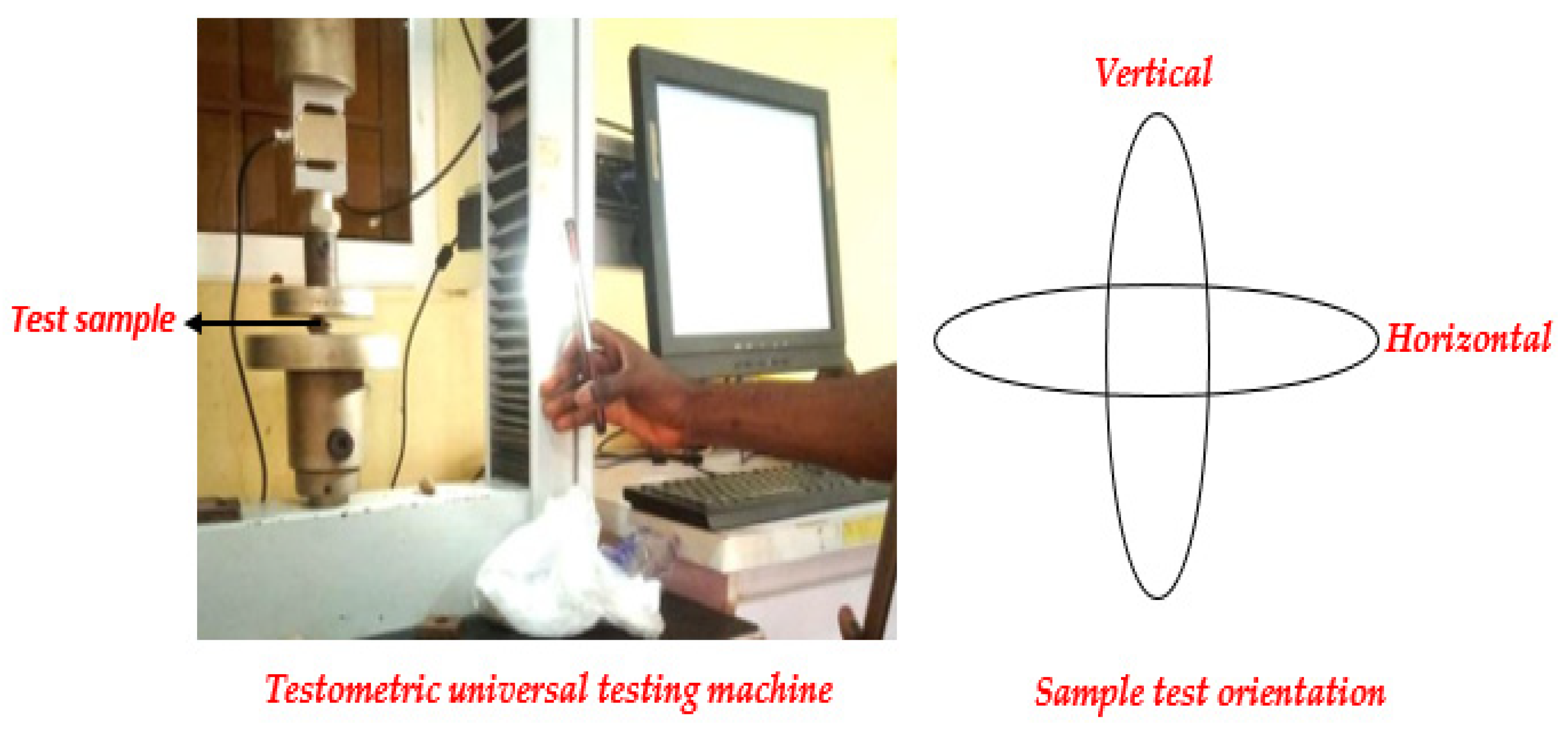
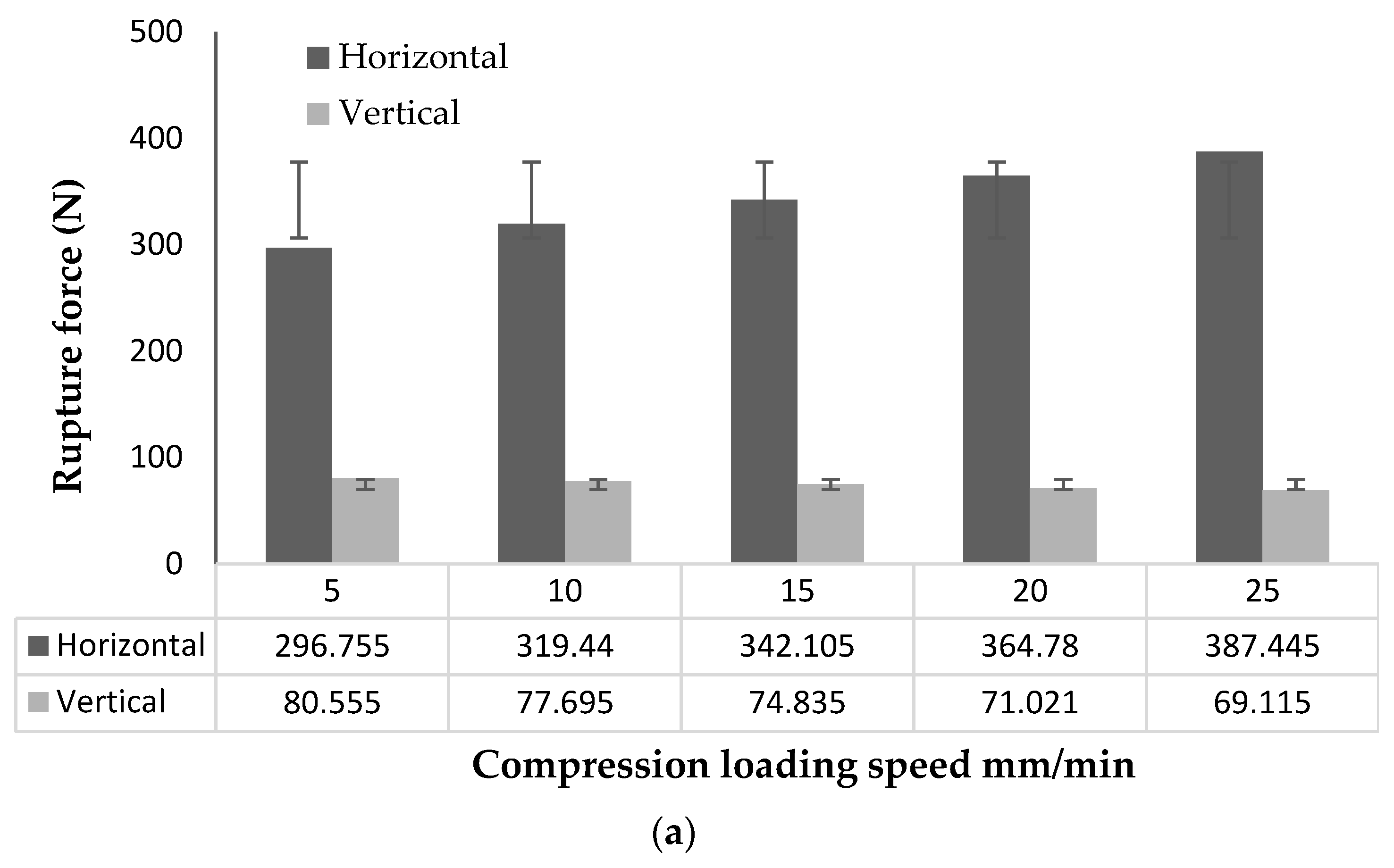



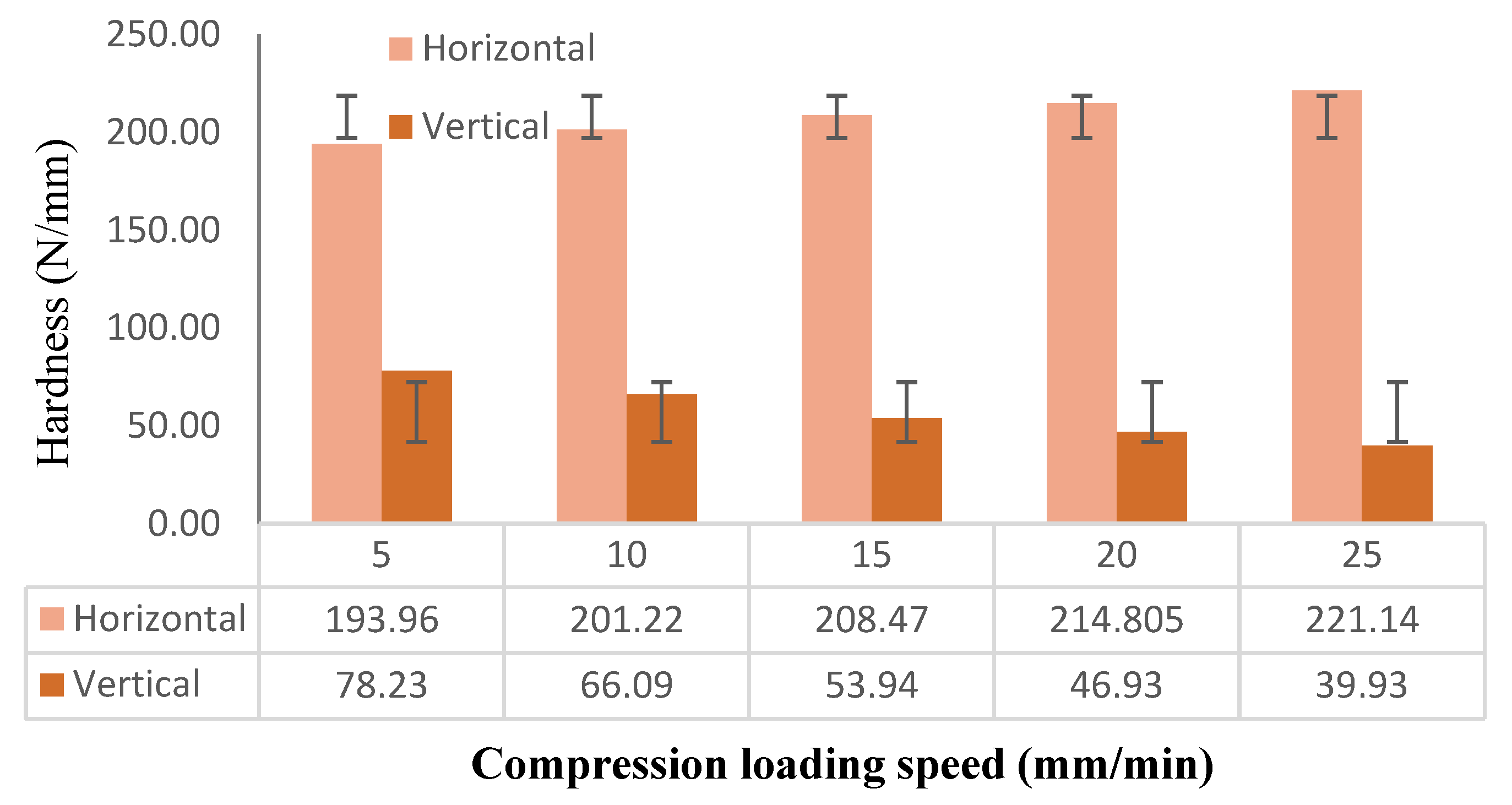

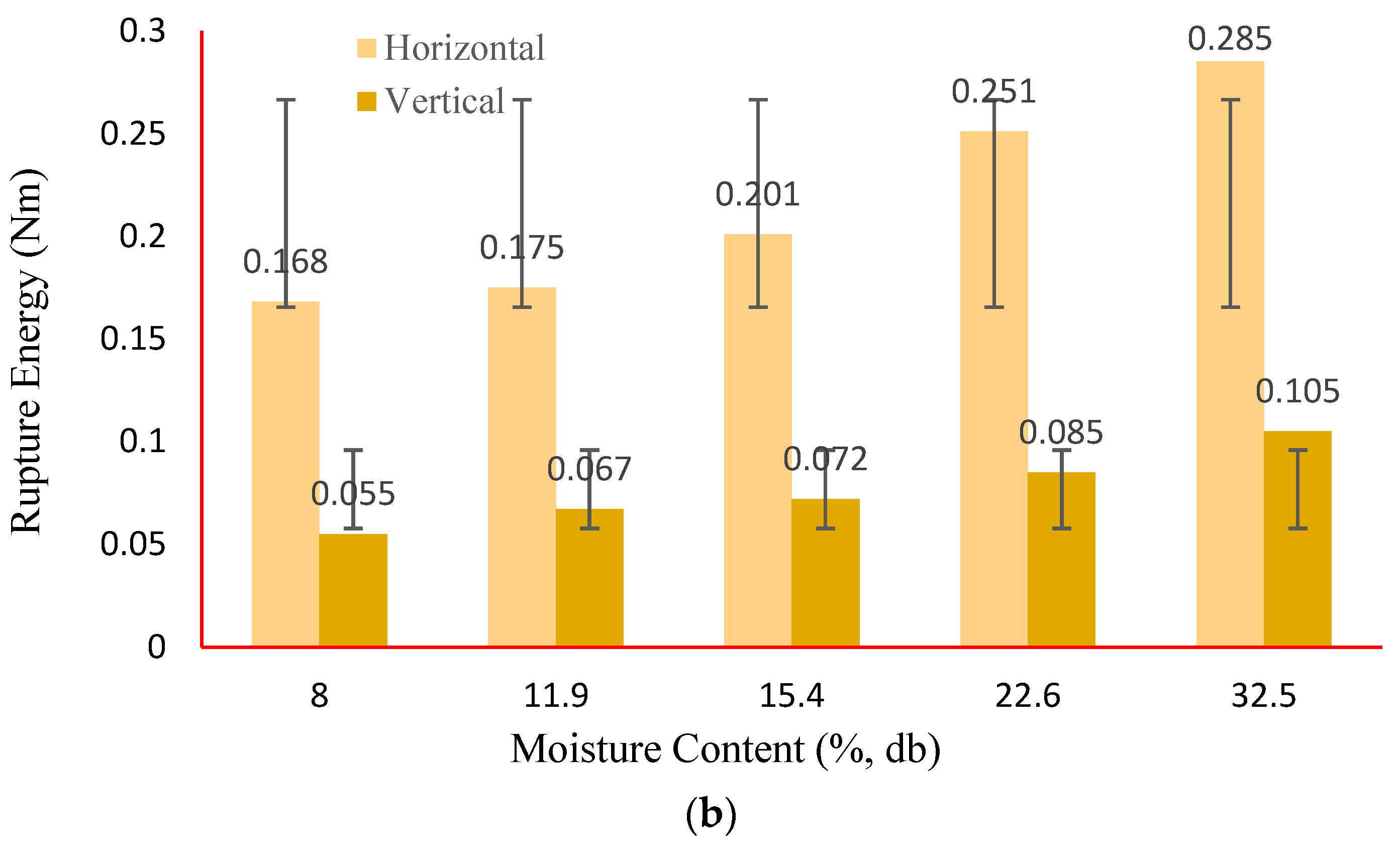
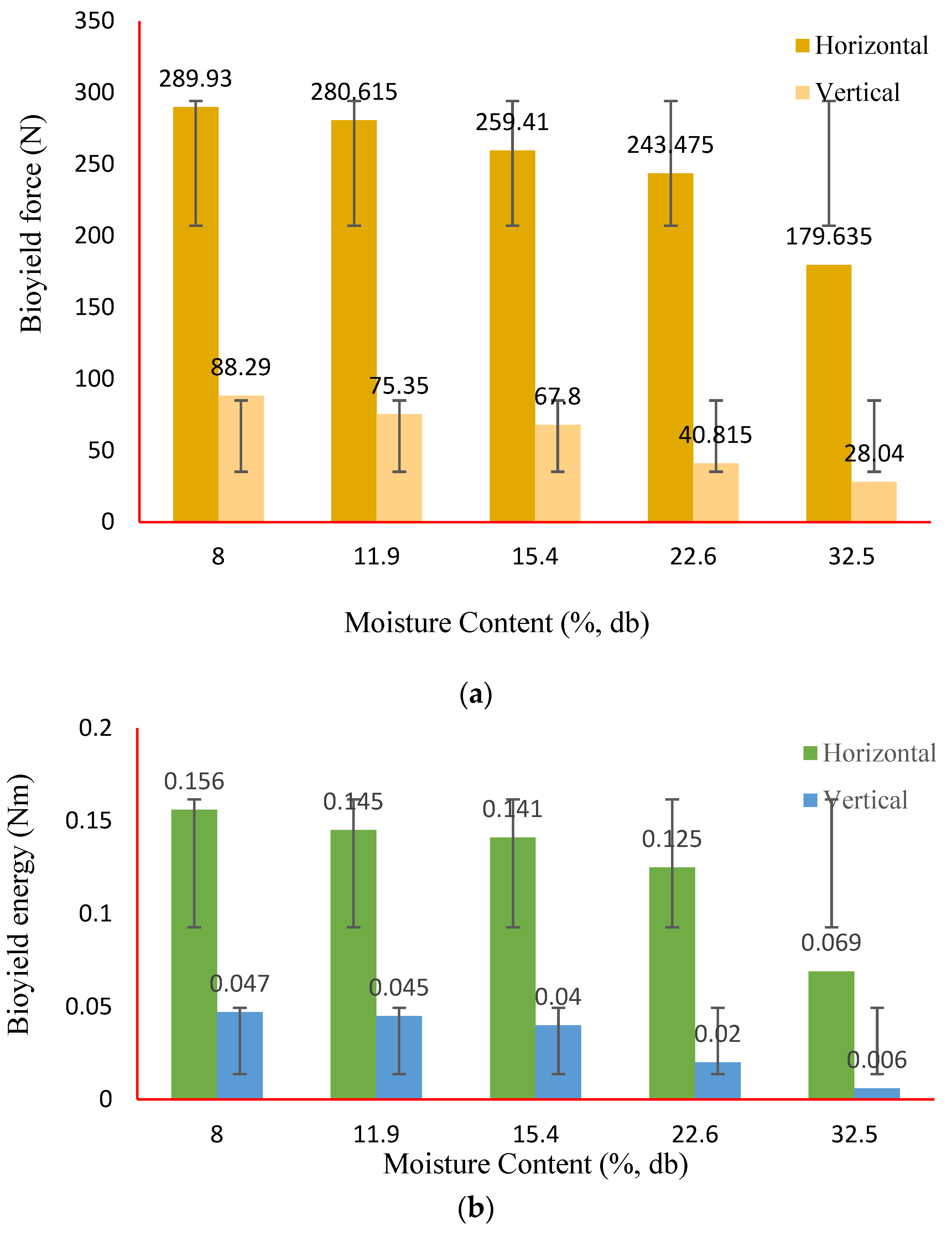


| Compression Loading Speed (mm/min) | |||||
|---|---|---|---|---|---|
| Parameters | 5 | 10 | 15 | 20 | 25 |
| Compressive test at the seed’s horizontal loading position | |||||
| Rupture force (N) | 295.86 ± 0.01 a | 318.11 ± 0.01 b | 341.11 ± 0.1 c | 363.88 ± 0.1 d | 387.45 ± 0.01 e |
| Rupture energy (N.m) | 0.1643 ± 0.2 a | 0.1733 ± 0.01 a | 0.1977 ± 0.1 b | 0.2410 ± 0.1 c | 0.2740 ± 0.01 d |
| Bioyield force (N) | 286.26 ± 0.01 c | 312.98 ± 0.01 b | 337.35 ± 0.01 c | 362.05 ± 0.1 d | 385.78 ± 0.01 e |
| Bioyield energy (Nm) | 0.1593 ± 0.1 a | 0.1957 ± 0.01 b | 0.2337 ± 0.01 c | 0.2627 ± 0.01 d | 0.2950 ± 0.1 e |
| Def. at rupture point (mm) | 0.1643 ± 0.01 a | 0.1733 ± 0.01 a | 0.1977 ± 0.21 b | 0.2410 ± 0.1 c | 0.2740 ± 0.1 d |
| Hardness (N/mm) | 192.63 ± 0.01 a | 200.22 ± 0.01 b | 207.14 ± 0.01 c | 213.47 ± 0.01 d | 219.80 ± 0.01 e |
| Compressive test at the seed’s vertical loading position | |||||
| Rupture force (N) | 81.89 ± 0.01 d | 78.66 ± 0.1 c | 75.50 ± 0.1 b | 72.02 ± 0.01 a | 69.44 ± 0.01 a |
| Rupture energy (Nm) | 0.0483 ± 0.1 a | 0.0610 ± 0.1 ab | 0.0687 ± 0.1 bc | 0.0817 ± 0.01 c | 0.1040 ± 0.01 d |
| Bioyield force (N) | 86.95 ± 0.01 e | 70.88 ± 0.01 d | 53.48 ± 0.01 c | 31.49 ± 0.1 b | 20.99 ± 0.01 a |
| Bioyield energy (Nm) | 0.0437 ± 0.1 c | 0.0355 ± 0.01 c | 0.0253 ± 0.1 b | 0.0250 ± 0.01 b | 0.0070 ± 0.01 a |
| Def. at rupture point (mm) | 1.5173 ± 0.01 a | 1.7610 ± 0.01 b | 2.0580 ± 0.1 c | 2.2667 ± 0.1 d | 2.5077 ± 0.1 e |
| Hardness (N/mm) | 76.56 ± 0.01 e | 64.75 ± 0.01 d | 53.24 ± 0.01 c | 45.43 ± 0.01 b | 38.73 ± 0.01 a |
| Sum of Squares | df | Mean Square | F | Sig. | ||
|---|---|---|---|---|---|---|
| Hrup. Force (N) | Between Groups | 15,302.766 | 4 | 3825.691 | 893.713 | 0.001 |
| Within Groups | 42.807 | 10 | 4.281 | |||
| Total | 15,345.572 | 14 | ||||
| Hrup. Energy (Nm) | Between Groups | 0.026 | 4 | 0.006 | 43.485 | 0.001 |
| Within Groups | 0.001 | 10 | 0.000 | |||
| Total | 0.027 | 14 | ||||
| Vrup. Force (N) | Between Groups | 298.599 | 4 | 74.650 | 29.152 | 0.002 |
| Within Groups | 25.607 | 10 | 2.561 | |||
| Total | 324.206 | 14 | ||||
| Vrup. Energy (Nm) | Between Groups | 0.007 | 4 | 0.002 | 13.996 | 0.001 |
| Within Groups | 0.001 | 10 | 0.000 | |||
| Total | 0.008 | 14 | ||||
| HDat.rupt (mm) | Between Groups | 0.348 | 4 | 0.087 | 1.975 | 0.174 |
| Within Groups | 0.441 | 10 | 0.044 | |||
| Total | 0.789 | 14 | ||||
| Hhardness (N/mm) | Between Groups | 1373.606 | 4 | 343.401 | 70.562 | 0.003 |
| Within Groups | 48.667 | 10 | 4.867 | |||
| Total | 1422.272 | 14 | ||||
| VDat.rup (mm) | Between Groups | 1.860 | 4 | 0.465 | 67.423 | 0.015 |
| Within Groups | 0.069 | 10 | 0.007 | |||
| Total | 1.928 | 14 | ||||
| Vhardness (N/mm) | Between Groups | 2750.393 | 4 | 687.598 | 131.188 | 0.002 |
| Within Groups | 52.413 | 10 | 5.241 | |||
| Total | 2802.806 | 14 | ||||
| HBio.yield force (N) | Between Groups | 18,475.206 | 4 | 4618.801 | 712.473 | 0.001 |
| Within Groups | 64.828 | 10 | 6.483 | |||
| Total | 18,540.034 | 14 | ||||
| VBio.yield force (N) | Between Groups | 8879.109 | 4 | 2219.777 | 723.840 | 0.010 |
| Within Groups | 30.667 | 10 | 3.067 | |||
| Total | 8909.776 | 14 | ||||
| Hbio.energy (Nm) | Between Groups | 0.034 | 4 | 0.009 | 58.681 | 0.021 |
| Within Groups | 0.001 | 10 | 0.000 | |||
| Total | 0.036 | 14 | ||||
| VBio.energy (Nm) | Between Groups | 0.002 | 4 | 0.001 | 22.751 | 0.001 |
| Within Groups | 0.000 | 10 | 0.000 | |||
| Total | 0.003 | 14 | ||||
| Regression Models | |
|---|---|
| Horizontal loading position | |
| Drpt | |
| Vertical loading position | |
| Be | |
| Drpt | |
| Moisture Content (%, db) | |||||
|---|---|---|---|---|---|
| Parameters | 8.0 | 11.9 | 15.4 | 22.6 | 32.5 |
| Compressive test at the seed’s horizontal loading position | |||||
| Rupture force (N) | 297.74 ± 0.01 d | 294.37 ± 0.04 d | 280.41 ± 0.10 c | 246.88 ± 0.1 b | 179.97 ± 0.13 a |
| Rupture energy (N.m) | 0.1573 ± 0.20 a | 0.1707 ± 0.1 a | 0.1977 ± 0.1 b | 0.241 ± 0.4 c | 0.2774 ± 0.1 d |
| Bioyield force (N) | 288.26 ± 0.10 c | 264.62 ± 0.31 bc | 265.01 ± 0.01 bc | 242.01 ± 0.1 b | 178.27 ± 0.01 a |
| Bioyield energy (Nm) | 0.1547 ± 0.1 c | 0.1360 ± 0.01 b | 0.1360 ± 0.02 b | 0.1333 ± 0.01 b | 0.673 ± 0.05 a |
| Def. at rupture point (mm) | 1.511 ± 0.01 c | 1.502 ± 0.41 c | 1.504 ± 0.11 c | 1.401 ± 0.12 b | 1.091 ± 0.03 a |
| Hardness (N/mm) | 197.04 ± 0.03 e | 195.37 ± 0.01 d | 186.44 ± 0.02 c | 176.21 ± 0.05 b | 164.96 ± 0.12 a |
| Compressive test at the seed’s vertical loading position | |||||
| Rupture force (N) | 102.82 ± 0.01 c | 84.48 ± 0.1 ab | 80.56 ± 0.1 b | 50.23 ± 0.14 c | 45.21 ± 0.2 d |
| Rupture energy (Nm) | 0.055 ± 0.1 a | 0.067 ± 0.1 a | 0.072 ± 0.1 b | 0.085 ± 0.01 c | 0.1083 ± 0.01 d |
| Bioyield force (N) | 87.66 ± 0.01 c | 67.68 ± 0.01 b | 66.46 ± 0.01 b | 36.68 ± 0.1 a | 27.04 ± 0.01 a |
| Bioyield energy (Nm) | 0.503 ± 0.1 c | 0.383 ± 0.01 b | 0.413 ± 0.1 bc | 0.127 ± 0.01 a | 0.0073 ± 0.01 a |
| Def. at rupture point (mm) | 1.484 ± 0.01 d | 1.461 ± 0.01 d | 1.401 ± 0.1 c | 1.015 ± 0.1 b | 0.922 ± 0.1 a |
| Hardness (N/mm) | 69.47 ± 1.21 e | 57.86 ± 0.21 d | 57.50 ± 3.01 d | 49.45 ± 0.32 a | 49.03 ± 2.01 a |
| Sum of Squares | df | Mean Square | F | Sig. | ||
|---|---|---|---|---|---|---|
| Hrup.force (N) | Between Groups | 28,797.557 | 4 | 7199.389 | 791.297 | 0.005 |
| Within Groups | 90.982 | 10 | 9.098 | |||
| Total | 28,888.540 | 14 | ||||
| Hrup.energy (Nm) | Between Groups | 0.030 | 4 | 0.007 | 41.167 | 0.001 |
| Within Groups | 0.002 | 10 | 0.000 | |||
| Total | 0.032 | 14 | ||||
| Vrup.force (N) | Between Groups | 6459.480 | 4 | 1614.870 | 74.810 | 0.025 |
| Within Groups | 215.864 | 10 | 21.586 | |||
| Total | 6675.344 | 14 | ||||
| Vrup.energy (Nm) | Between Groups | 0.006 | 4 | 0.002 | 33.056 | 0.005 |
| Within Groups | 0.000 | 10 | 0.000 | |||
| Total | 0.007 | 14 | ||||
| HDat.rupt (mm) | Between Groups | 0.894 | 4 | 0.224 | 92.893 | 0.013 |
| Within Groups | 0.024 | 10 | 0.002 | |||
| Total | 0.918 | 14 | ||||
| Hhardness (N/mm) | Between Groups | 7939.281 | 4 | 1984.820 | 886.756 | 0.002 |
| Within Groups | 22.383 | 10 | 2.238 | |||
| Total | 7961.664 | 14 | ||||
| VDat.rup (mm) | Between Groups | 2.017 | 4 | 0.504 | 434.675 | 0.001 |
| Within Groups | 0.012 | 10 | 0.001 | |||
| Total | 2.028 | 14 | ||||
| Vhardness (N/mm) | Between Groups | 1947.709 | 4 | 486.927 | 303.861 | 0.030 |
| Within Groups | 16.025 | 10 | 1.602 | |||
| Total | 1963.733 | 14 | ||||
| HBio.yield force (N) | Between Groups | 21,252.799 | 4 | 5313.200 | 29.535 | 0.001 |
| Within Groups | 1798.940 | 10 | 179.894 | |||
| Total | 23,051.739 | 14 | ||||
| VBio.yield force (N) | Between Groups | 7361.889 | 4 | 1840.472 | 62.805 | 0.005 |
| Within Groups | 293.047 | 10 | 29.305 | |||
| Total | 7654.936 | 14 | ||||
| HBio.energy (Nm) | Between Groups | 0.014 | 4 | 0.003 | 51.947 | 0.010 |
| Within Groups | 0.001 | 10 | 0.000 | |||
| Total | 0.014 | 14 | ||||
| VBio.energy (Nm) | Between Groups | 0.004 | 4 | 0.001 | 37.471 | 0.003 |
| Within Groups | 0.000 | 10 | 0.000 | |||
| Total | 0.005 | 14 | ||||
| Regression Models | |
|---|---|
| Horizontal loading position | |
| Drpt | |
| Vertical loading position | |
| Be | |
| Drpt | |
Disclaimer/Publisher’s Note: The statements, opinions and data contained in all publications are solely those of the individual author(s) and contributor(s) and not of MDPI and/or the editor(s). MDPI and/or the editor(s) disclaim responsibility for any injury to people or property resulting from any ideas, methods, instructions or products referred to in the content. |
© 2025 by the authors. Licensee MDPI, Basel, Switzerland. This article is an open access article distributed under the terms and conditions of the Creative Commons Attribution (CC BY) license (https://creativecommons.org/licenses/by/4.0/).
Share and Cite
Oloyede, C.T.; Jekayinfa, S.O.; Enweremadu, C.C.; Oluborode, I. Compression Loading Behaviour of Anonna squamosa Seeds for Sustainable Biodiesel Synthesis. AgriEngineering 2025, 7, 104. https://doi.org/10.3390/agriengineering7040104
Oloyede CT, Jekayinfa SO, Enweremadu CC, Oluborode I. Compression Loading Behaviour of Anonna squamosa Seeds for Sustainable Biodiesel Synthesis. AgriEngineering. 2025; 7(4):104. https://doi.org/10.3390/agriengineering7040104
Chicago/Turabian StyleOloyede, Christopher Tunji, Simeon Olatayo Jekayinfa, Christopher Chintua Enweremadu, and Iyanuoluwa Oluborode. 2025. "Compression Loading Behaviour of Anonna squamosa Seeds for Sustainable Biodiesel Synthesis" AgriEngineering 7, no. 4: 104. https://doi.org/10.3390/agriengineering7040104
APA StyleOloyede, C. T., Jekayinfa, S. O., Enweremadu, C. C., & Oluborode, I. (2025). Compression Loading Behaviour of Anonna squamosa Seeds for Sustainable Biodiesel Synthesis. AgriEngineering, 7(4), 104. https://doi.org/10.3390/agriengineering7040104








